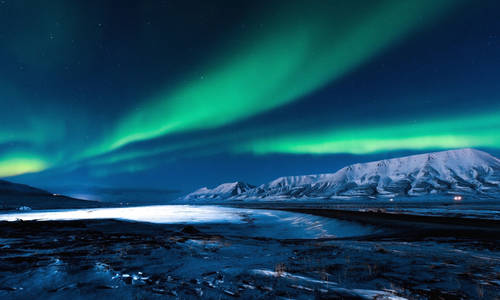Article content
1 April 2009 by Pete Mathers
With whales spotted in summer, the Northern Lights in winter, and some of the strangest, most dramatic landscapes on earth, Iceland is a year-round destination just begging to be explored.
Iceland puts the wild in wilderness. Neil Armstrong came here to train for his lunar walk. Rumour has it he found the scenery on the moon a little drab in comparison. It also plays host to Europe’s largest national park, Vatnajokull – over three million acres of plains, volcanoes, lava beds, lakes and ravines, situated in the island’s south-east.
While some areas, such as the spectacular, iceberg-studded Jökulsárlón lagoon, attract visitors, much of the park is a wilderness. Seven volcanoes, most of them active, are located under the Vatnajokull ice cap, one of the largest glaciers in Europe.
The superlatives continue when it comes to waterfalls. Dettifoss, in the north-east, is the largest, most powerful waterfall in Europe, a foaming torrent dispatching 500 cubic metres of water per second down a 44m horseshoe-shaped precipice.
Refreshingly, there are very few barriers to keep you from enjoying its natural beauty. In Iceland, common sense is considered good enough – don’t fall in the waterfall and you won’t get hurt. All across the country, the land is riddled with suppurating mud pits, sulphurous steam vents and lava flows reminiscent of blackened school dinners. Stunted trees cower inches above the ground, sheltering from the scything Arctic winds, and deserts of black ash double as scenic byroads.
Yet for all its austerity, it has a gentler side too. Its name, for example, is distinctly misleading. Far from being covered in ice, Iceland is really green. On a good day, of which there are many, it can make Ireland look a bit short-changed in the 40 shades of emerald department.
There is grass and heather, and sapphire-blue rivers watering verdant valleys and rolling green hills. The capital, Reykjavik, is the northernmost capital city in the world. Meaning ‘Smoky Bay’, Reykjavik was so named by its Viking founder because of the steam that rises from the surrounding hot springs. But it’s anything but smoky. In fact, it’s entirely smoke free, thanks to a reliance on geothermal heating.
As our resident Iceland expert, Simon Clifford, will tell you, it has all the trappings of a modern European city – first class hotels, shopping malls, theatres, galleries, museums and excellent restaurants offering everything from smoked puffin to 101 recipes for cod. It’s also far more affordable than it has been in years. “Where a beer once coast £6, it now costs around £4,” says Simon. “For a really memorable meal, head to Lækjarbrekka in the city centre; traditional fare includes lobster, elk and delicious mountain lamb.”
Close to Reykjavik is Iceland’s most famous attraction: the Blue Lagoon, where visitors can bathe in naturally heated, mineral-rich waters. It’s about as weird and wonderful as swimming pools get. Wading into waistdeep, milky-blue water, bubbling away at 37–39°C, you feel a layer of sludge squelch between your toes. The mud is in fact terribly therapeutic, and you can lie there for hours with it masked upon your face. Folklore plays a vital role in Icelandic culture.
Around 80% of the population admit to believing in so-called ‘hidden people’: gnomes, elves, fairies, trolls and the like. When unexplained mechanical failure interrupted an extension to the Blue Lagoon in 2006, staff lit candles to appease the elves whose homes had been disturbed. Another guaranteed hit is the Golden Circle, a geologically supercharged tour that visits Thingvellir (a unesco site of lava flows and deep ravines), Geysir (a hotspot of geothermal vents, including the Strokkur geyser which erupts 20m every few minutes) and Gullfoss (a beautiful 32m-high waterfall).
Circle; the spectacular south coast (highlights are Skógafoss waterfall, Myrdalsjökull glacier and the Eldhraun lava field); Vatnajokull National Park and the icebergs of Jökulsárlón lagoon; the eastern fjords (where in summer you can take a boat to Papey Island to see thousands of nesting puffins); the allpowerful Dettifoss waterfall; Lake Myvatn (a striking region of lunaresque craters and grassy shores teeming with waterfowl); and the fertile valley of Skagafjördur (renowned for breeding Icelandic horses, arguably the purest in the world).
In addition, the route gives you time to explore the lesser-known West Fjords and the beautiful Snæfellsnes Peninsula. The West Fjords are some of the oldest parts of Iceland. There are golden sandy beaches, high sea cliffs occupied by millions of seabirds, remarkable waterfalls and cool glacial valleys. The Snæfellsnes Peninsula is a natural wonder with its own ice cap, volcanoes, fjords and farming districts. The glacier is believed to hold mystical powers, and the views from the top are most certainly magical.
If you haven’t the two weeks required for such a trip then consider a shorter option. ‘South Iceland’s Favourite Attractions’ combines Reykjavik with the most popular attractions in the south: the Gullfoss waterfall, the hot springs of Geysir, Thingvellir National Park and of course the Blue Lagoon. It’s an action-packed five-day tour, running in both summer and winter. From April to October, a day is given over to whale watching in Faxafloi Bay and sightseeing on the aptly named Puffin Island. From November to March, visitors enjoy an evening of excitement hunting for the ethereal Northern Lights.
So whenever you’re in need of some northern exposure, Iceland is waiting to deliver, just try not to anger the fairy folk.






